- By Dan Veaner
- Around Town
 Print
Print  wf_flag120sq_5318.jpgAs the sun is hidden by the hills on the far side of the lake, a Civil War cannon is fired. That is the signal to light the watchfire that will be a beacon to bring home all those soldiers missing in action. The wood pile is the size of a house, and soon the flames are reaching twenty, thirty feet and more into the air. Soldiers past, present, and future break formation to line up to throw more wood onto the fire to honor the missing and the dead.
wf_flag120sq_5318.jpgAs the sun is hidden by the hills on the far side of the lake, a Civil War cannon is fired. That is the signal to light the watchfire that will be a beacon to bring home all those soldiers missing in action. The wood pile is the size of a house, and soon the flames are reaching twenty, thirty feet and more into the air. Soldiers past, present, and future break formation to line up to throw more wood onto the fire to honor the missing and the dead.That was the scene in Lansing's Myers Park last Friday as Fingerlakes Chapter 377 and Cayuga County Chapter 704 of the Vietnam Veterans of America hosted the 16th annual POW/MIA Recognition Day watchfire there. "It says that we won't forget you," says Mike Moran, a First Lieutenant at the end of his four years in the Army, and a Major after 17 years in the Reserves. "Americans do so much to try to recover or rescue soldiers. We have a 'no one left behind' mentality, and we're probably the only military that really, really works at that."
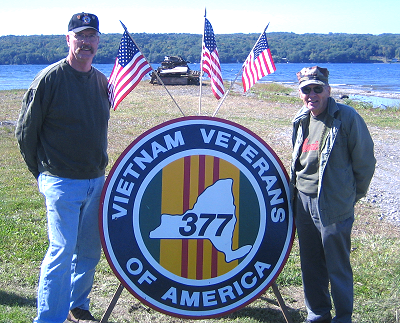
Mike Moran (left) and holly Hollingsworth
The ROTC brigade from Cornell and Ithaca College, many veterans groups, and families of those who lost people in a war gathered to hear Moran speak about those who are lost and the efforts being made to find their remains. Moran says 1,761 Americans are still missing in Viet Nam. They've recovered 842 sets of remains and have been working to identify them. That is possible because of forensic techniques such as DNA matching that even helped the Army identify the Unknown Soldier from the Vietnamese war.
"DNA has made a big difference," says Holly Hollingsworth, one of the organizers and a Cold War veteran. "They have DNA from most of the families of those missing in Viet Nam. So now when they bring back remains from Viet Nam they can identify them. Sometimes it takes several years."

The wood pile started small, but grew to the size of a house
The wood for the enormous fire was donated by NV Lumber, palettes from various companies, and individuals. Cargill Salt Mine donated the use of a payloader and men to help stack the wood. The Sons of Union Veterans of the Civil War brought a mountain Howitzer that is over 100 years old to signal the lighting of the fire. The Endicott-based group were decked out in historical uniforms, and when the time came the little cannon made a remarkably loud report.
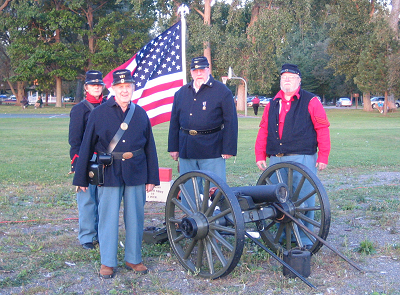 (Left to right) Cheryl Deuel, Al Kline, Tom Crounse, and Doug Deuel stand ready to fire a Civil War era cannon |
"It's a sneak gun," says Douglas Deuel, who led the group. "They used to set it on a railroad track and disable locomotives, put a canister in there and eliminate the crews, clean up the mess, pull the six pins, put it on three mules and disappear in three minutes."
"Watchfires were started by Vietnam veterans chapters," Moran says. "It came from one of the Hudson River chapters. But the story of watchfires is varied in American history. Washington used watchfires to signal the end of the Revolution. The Battle Hymn of the Republic says, 'I have seen Him in the watchfires Of a hundred circling camps,' and more recently watchfires have been a symbol to remember POWs and MIAs. It is lit to show the way home."
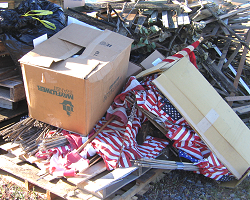 | 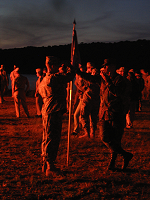 |
| Flags used in cemeteries (left) are properly disposed of by fire. Saluting the flag (right). | |
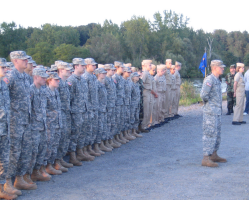 | 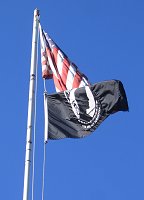 |
Hollingsworth says they have only canceled once, and that was because of a hurricane. And before watchfires the veterans were still active in remembering the missing. "The first thing we did for POW/MIA recognition day was a balloon release at TC3," he recalls. "At that time there were about 3,000 soldiers missing. That's how many balloons we released. The next year we released 144 balloons from the VFW in Ithaca, because that's how many were missing at that time from New York State. Then that night we came to Myers Park for our first watchfire."
They have learned a bit about watchfires since then. "The fun comes on Sunday when we clean up all the nails," Hollingsworth says. "The first year we did it guys had plastic pails, but they melted. The nails were still so hot they melted a liner in a pickup truck."
Now the group uses large magnets to locate the nails. "The most amazing thing about the whole event is the following day by lunchtime you could walk out there and you'd never know it ever happened. I don't know how they pick that stuff up, but they pick everything up. They do a great job."
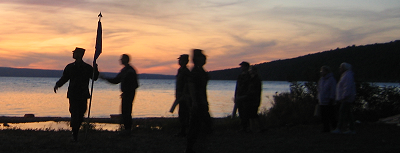
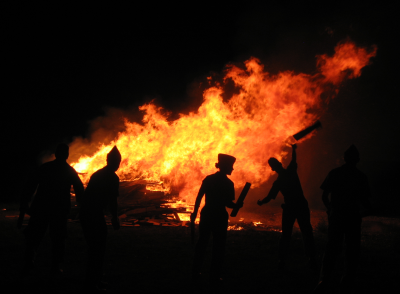
Hollingsworth says that people come to the event from far and wide, some following the glow up the lake from Ithaca, others coming from out of state. "One of the most rewarding incidents was when a young lady visited from California," he says. "Her dad was a pilot in Viet Name and was missing. They had never had anything like this where she lived. It was an emotional experience not only for her, but for the veterans. She talked to a lot of the members and it really made this worthwhile, because we're trying to keep the POW issue alive and let people know we're concerned."
He points out that POW/MIA Recognition Day also recognizes those that did come back that were prisoners of war or missing in action. While a few typically attend the event he says they don't want any special recognition.
When you consider the scope of the wars involved it it remarkable how few warriers are actually missing. "That's because we go back to recover them," Moran says. "It's a promise to each other that we'll come back for you."
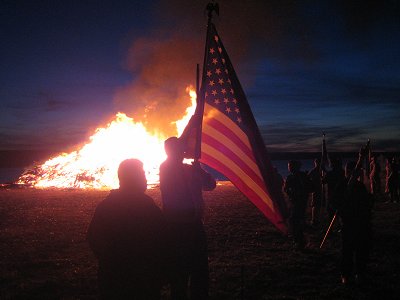
----
v4i37



